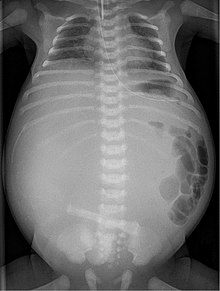|
Meconium peritonitis
Meconium peritonitis refers to rupture of the bowel prior to birth, resulting in fetal stool (meconium) escaping into the surrounding space (peritoneum) leading to inflammation (peritonitis). Despite the bowel rupture, many infants born after meconium peritonitis in utero have normal bowels and have no further issues. Infants with cystic fibrosis are at increased risk for meconium peritonitis. Signs and symptoms
DiagnosisTwenty percent of infants born with meconium peritonitis will have vomiting and dilated bowels on x-rays which necessitates surgery.[citation needed] Meconium peritonitis is sometimes diagnosed on prenatal ultrasound[1] where it appears as calcifications[2] within the peritoneum. TreatmentAdhesiolysis partial resection of pseudocyst covering enterostomy.[citation needed] HistoryMeconium peritonitis was first described in 1838 by Carl von Rokitansky.[citation needed] References
External links |
||||||||||
